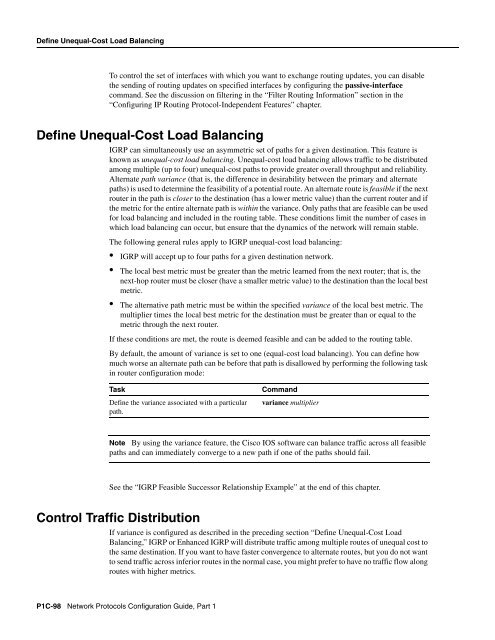Configuring IGRP - The Cisco Learning Network
Configuring IGRP - The Cisco Learning Network
Configuring IGRP - The Cisco Learning Network
Create successful ePaper yourself
Turn your PDF publications into a flip-book with our unique Google optimized e-Paper software.
Define Unequal-Cost Load Balancing<br />
To control the set of interfaces with which you want to exchange routing updates, you can disable<br />
the sending of routing updates on specified interfaces by configuring the passive-interface<br />
command. See the discussion on filtering in the “Filter Routing Information” section in the<br />
“<strong>Configuring</strong> IP Routing Protocol-Independent Features” chapter.<br />
Define Unequal-Cost Load Balancing<br />
<strong>IGRP</strong> can simultaneously use an asymmetric set of paths for a given destination. This feature is<br />
known as unequal-cost load balancing. Unequal-cost load balancing allows traffic to be distributed<br />
among multiple (up to four) unequal-cost paths to provide greater overall throughput and reliability.<br />
Alternate path variance (that is, the difference in desirability between the primary and alternate<br />
paths) is used to determine the feasibility of a potential route. An alternate route is feasible if the next<br />
router in the path is closer to the destination (has a lower metric value) than the current router and if<br />
the metric for the entire alternate path is within the variance. Only paths that are feasible can be used<br />
for load balancing and included in the routing table. <strong>The</strong>se conditions limit the number of cases in<br />
which load balancing can occur, but ensure that the dynamics of the network will remain stable.<br />
<strong>The</strong> following general rules apply to <strong>IGRP</strong> unequal-cost load balancing:<br />
<strong>IGRP</strong> will accept up to four paths for a given destination network.<br />
<strong>The</strong> local best metric must be greater than the metric learned from the next router; that is, the<br />
next-hop router must be closer (have a smaller metric value) to the destination than the local best<br />
metric.<br />
<strong>The</strong> alternative path metric must be within the specified variance of the local best metric. <strong>The</strong><br />
multiplier times the local best metric for the destination must be greater than or equal to the<br />
metric through the next router.<br />
If these conditions are met, the route is deemed feasible and can be added to the routing table.<br />
By default, the amount of variance is set to one (equal-cost load balancing). You can define how<br />
much worse an alternate path can be before that path is disallowed by performing the following task<br />
in router configuration mode:<br />
Task Command<br />
Define the variance associated with a particular<br />
path.<br />
variance multiplier<br />
Note By using the variance feature, the <strong>Cisco</strong> IOS software can balance traffic across all feasible<br />
paths and can immediately converge to a new path if one of the paths should fail.<br />
See the “<strong>IGRP</strong> Feasible Successor Relationship Example” at the end of this chapter.<br />
Control Traffic Distribution<br />
If variance is configured as described in the preceding section “Define Unequal-Cost Load<br />
Balancing,” <strong>IGRP</strong> or Enhanced <strong>IGRP</strong> will distribute traffic among multiple routes of unequal cost to<br />
the same destination. If you want to have faster convergence to alternate routes, but you do not want<br />
to send traffic across inferior routes in the normal case, you might prefer to have no traffic flow along<br />
routes with higher metrics.<br />
P1C-98 <strong>Network</strong> Protocols Configuration Guide, Part 1

















